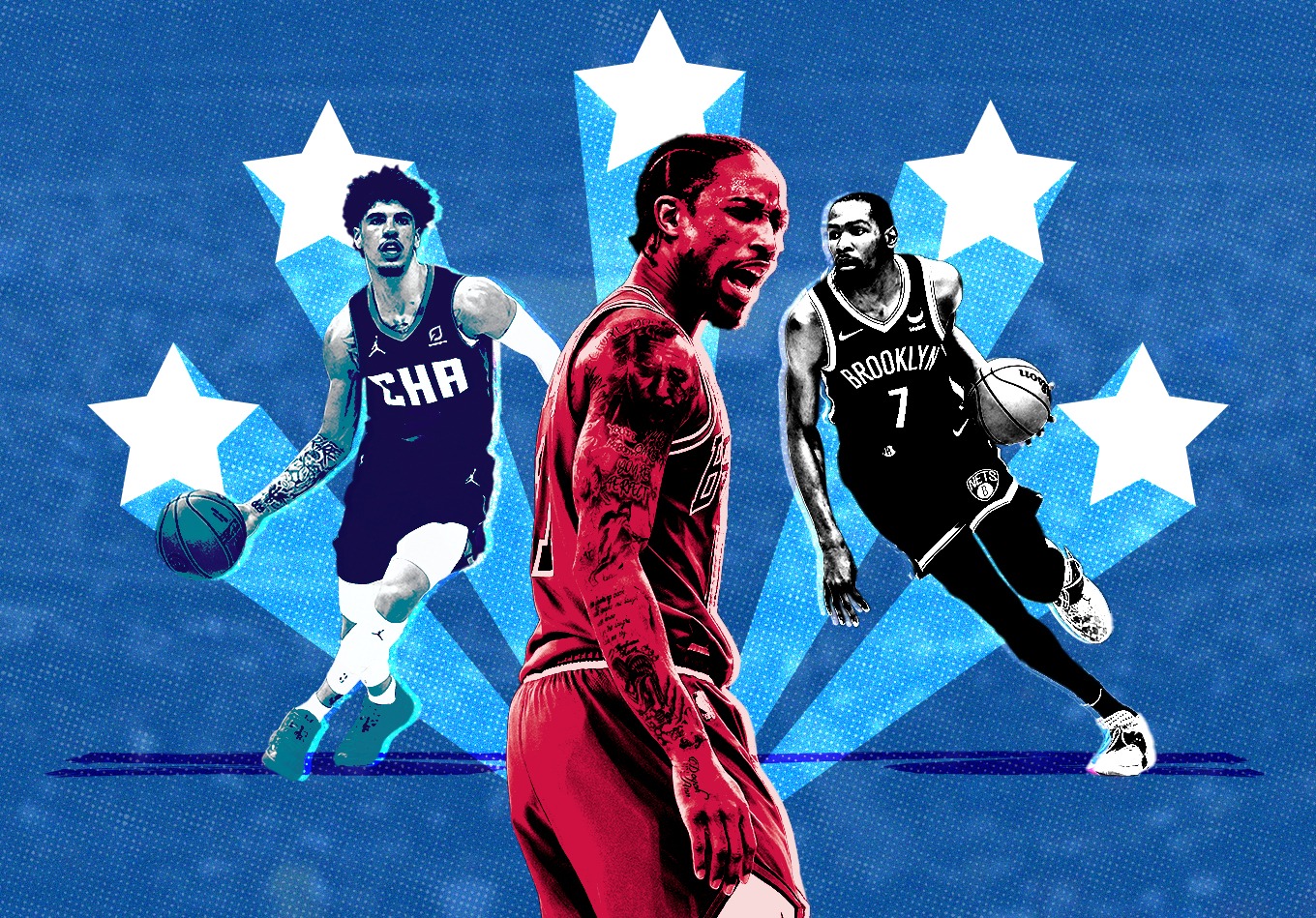A year ago at this time, the NBA season hadn’t even begun.
We were all still basking in the glow of Alex Caruso leading the Los Angeles Lakers to the franchise’s 17th NBA title and getting ready for a condensed preseason that saw Zion Williamson lead the league in scoring.
Only one of those guys has played in a basketball game in the last seven months, and while Zion is *clears throat* was on his way to returning from the fractured foot and, um, general conditioning concerns that have kept him off the floor, it probably won’t give him enough time to make a convincing case to belong in his second consecutive All-Star Game.
Even if Zion plays in every game (unlikely) between now and when the All-Star starters are announced (somewhere around Feb. 1) or reserves are picked (somewhere around Feb. 8), he’ll only have a 20-25 game resume to go off of. The coaches, who are responsible for selecting the reserves, certainly aren’t going to pick a guy who has missed half the season. He could be voted in as a starter considering the process now consists of four voting groups – split between the fans, players, media and Rich Paul (we’re kidding, of course: Paul won’t be part of the formula until 2023) – but good luck making it above two of LeBron James, Nikola Jokic, Paul George and Anthony Davis in the Western Conference frontcourt.
The NBA hasn’t really clarified what the format of the 2022 game will be – though the Elam Ending seems to be here to stay – but for the purposes of this exercise, we’ll assume it’s the same as last year: two backcourt starters, three frontcourt starters, two backcourt reserves, three frontcourt reserves and two wild cards for each conference.
So, who will be on the floor when the world’s greatest current players and possibly bonafide hooper Kyrie Irving meet in Cleveland on Feb. 20? Teams will have played between 56-60 games by that point, which means we’re basically halfway to the All-Star break.
Who belongs? Who doesn’t? Let’s let the numbers decide. We’ll take a look at the Eastern Conference, then head out West next time.
Backcourt Starters
Trae Young, Atlanta Hawks
It’s not surprising to see Young here after his outstanding playoff run that propelled the Hawks to the East finals. But he definitely had some kinks to work out in the early going. He averaged just 22.5 points and barely shot above 40% in Atlanta’s first nine games, taking just 5.2 3-pointers per game and making only 25.5% of them. In the 12 games since, he’s at 28.4 points per game, he’s taking eight 3s per contest and hitting 44.2% of them. He’s even found his way back to the free-throw line at a slightly higher rate after clearly struggling with the new rules early on.
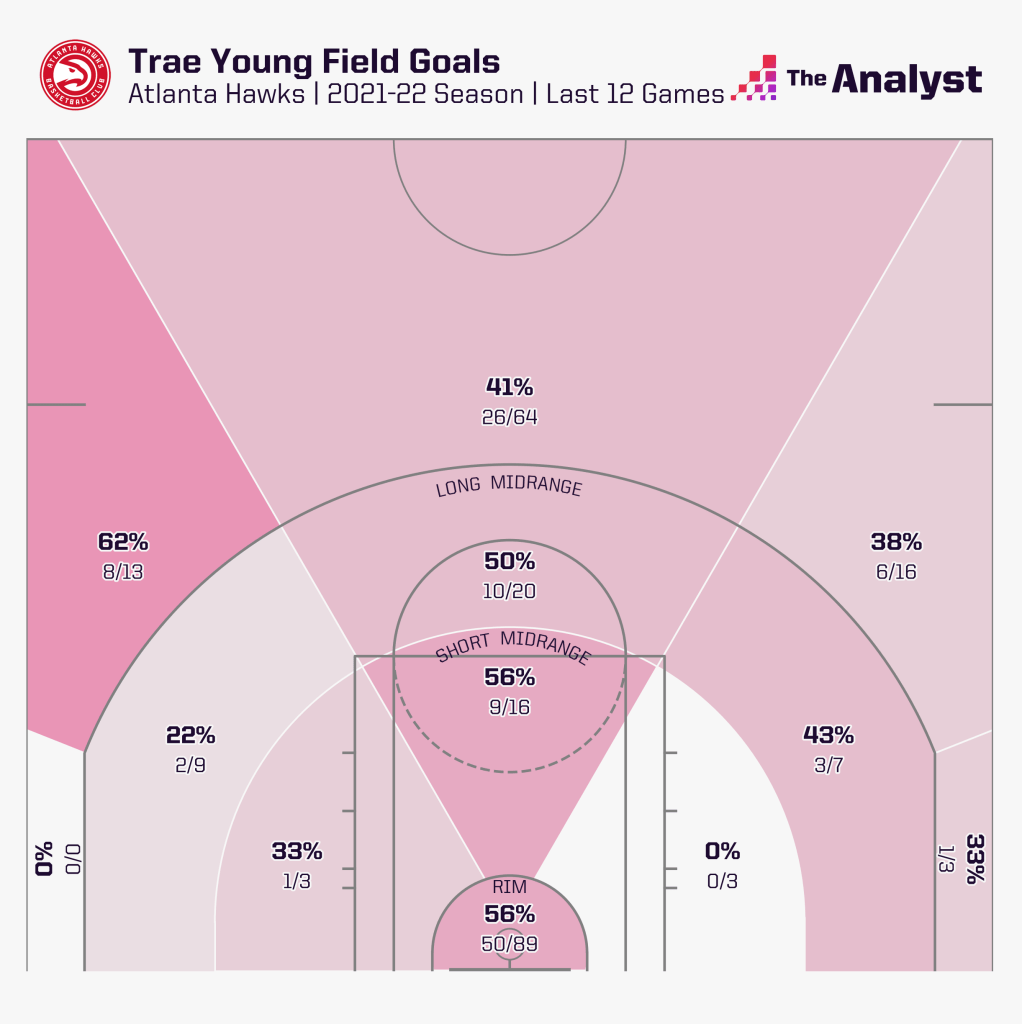
DeMar DeRozan, Chicago Bulls
Pairing DeRozan with Zach LaVine and Nikola Vucevic seemed like a fantasy basketball dream that would result in a lot of 138-133 losses in reality. Instead, the Bulls have a top-10 offense (110.5 points per 100 possessions) and defense (105.6). The city that’s home to one team that calls itself the Monsters of the Midway when they’re good once every quarter century or so now has its Master of the Midrange.
Most Midrange Shot Attempts Per Game (Since 2016-17)
| Player | Season | Midrange FGAs/G | Shooting% |
|---|---|---|---|
| DeRozan, TOR | 2016-17 | 10.1 | 41.2 |
| Anthony, NYK | 2016-17 | 9.0 | 45.4 |
| DeRozan, CHI | 2021-21 | 8.1 | 47.4 |
| Aldridge, SAS | 2016-17 | 7.9 | 41.2 |
| Davis, NOP | 2016-17 | 7.6 | 42.8 |
| Aldridge, SAS | 2017-18 | 7.4 | 42.5 |
| Westbrook, OKC | 2016-17 | 7.3 | 36.3 |
| DeRozan, SAS | 2018-19 | 7.2 | 40.5 |
| Ingram, NOP | 2021-22 | 7.4 | 42.1 |
| Wiggins, MIN | 2016-17 | 7.2 | 37.9 |
The Bulls lead the league in midrange field-goal attempts – DeRozan tends to bring that honor with him wherever he goes – and he’s even developed into at least a mild threat to shoot 3s (2.5 attempts per game), giving him the gravity to drive to the basket. With free throw attempts across the league down, DeRozan is getting to the line more often than he did last season in San Antonio.
You could easily make the case that teammate Zach LaVine should be starting – we’ll get to him – but DeRozan has been Chicago’s best player thus far. The Bulls have a plus-10.9 point difference per 100 possessions with DeRozan on the floor versus off (the difference with LaVine, surprisingly, is minus-6.5), and while there is some lineup noise in those numbers, they can’t be ignored even for a guy who’s hardly been known as a defensive plus. Guess playing next to Caruso will do that to you.
Frontcourt Starters
Giannis Antetokounmpo, Milwaukee Bucks
Shooting percentage aside, the Finals MVP’s numbers are basically at the same level they were during his back-to-back regular-season MVP campaigns in 2017-18 and 2018-19. The Greek Freak has been a one-man show for this Bucks team that’s missed Khris Middleton, Jrue Holiday and Bobby Portis for a chunk of games, hasn’t gotten Donte DiVincenzo back yet and has played just one game with Brook Lopez – who’s now recovering from back surgery – in the middle. Milwaukee is plus-15.0 per 100 possessions when he’s on the court and minus-11.4 when he sits, the second-widest disparity in the league behind Jokic. Giannis’ 10.0 free throw attempts per game are a career high and 1.7 more than the league’s No. 2 (Jimmy Butler). He’ll absolutely be in the discussion to win his third MVP in four seasons come spring.
Kevin Durant, Brooklyn Nets
We’d all be better off if Irving and Ben Simmons would inform Sean Marks and Daryl Morey that they’d only like to be traded for each other in the NBA’s first player-forced one-for-one blockbuster swap. The unvaccinated Irving could at least play in most of Philadelphia’s games, and Simmons could play in front of a Brooklyn crowd that may or may not be certain who the home team is at most of its games.
Between Irving’s absence, James Harden’s annual playing-his-way-into shape and Joe Harris’ recent injury, it’s almost all been on Durant’s shoulders – and he’s been excellent. Durant’s 3-point numbers are down a bit, but he’s shooting a career-high 56.0% from midrange.
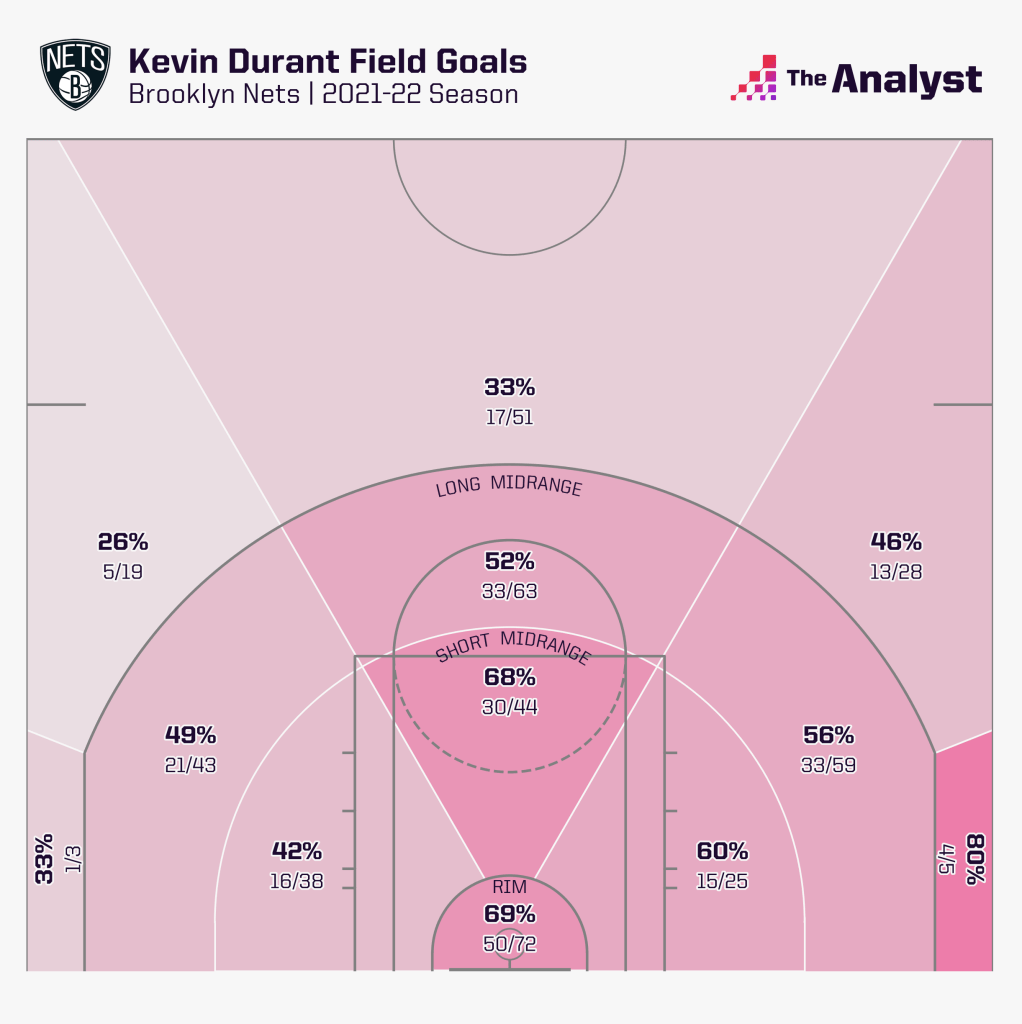
His assist percentage is a career-high 27.3 despite many of those passes having gone to *glances at Nets roster, eyes bulge out of head* Patty Mills, LaMarcus Aldridge and Blake Griffin. Durant’s lone MVP came in the 2013-14 season, when those three guys were all at their NBA apex. Mills is playing a bigger role than he has in his previous 12 seasons by necessity, Aldridge is doing fine in his limited minutes and Griffin has a better chance of being a featured player on SNL than he does in playing meaningful rotation minutes. And here’s Durant, leading the Nets to the best record in the East.
Jimmy Butler, Miami Heat
Come for the current Bulls swingman, stay for the former Bulls swingman. Like your favorite prestige TV drama, Butler’s performance in Miami made a jump from Season 1 to Season 2, and it’s gone to another level in Season 3. Butler is getting to his spots, and no one is going to reasonably slow him down. He draws 5.9 fouls per game – fourth in the NBA, and the guys who are ahead of him are all 7-footers. Butler posted up on just 6.2% of possessions a season ago, a rate he’s doubled this season at a top-12 efficiency level. He’s a defensive bulldog who has more steals than turnovers. When the Heat are healthy, they’re a legitimate threat to win the East – and Butler’s by far the biggest reason why.
Backcourt Reserves
LaMelo Ball, Charlotte Hornets
This game is meant for players like LaMelo, who has helped transform the Hornets into a fast-paced, must-watch team that is a consistent threat to drop 130 points on you if you’re not careful. Ball is averaging 20.0 points, 8.3 assists, 7.7 rebounds and 1.9 steals – a stat line only Russell Westbrook and Magic Johnson have ever reached since steals became an official statistic in the early 70s. He’s nearing 40% from 3-point range on 7.5 attempts per game. He’s 10th in VORP (1.2) and among the top 20 in DELTA (plus-1.2), our metric for exceeding preseason expectation of a player’s plus/minus per 100 possessions (DRIP). The most exciting part for Ball is that there’s still plenty of room for growth. He’s shooting 47.9% in the restricted area, which ranks 52nd of 55 players to take at least five attempts per game at the rim. That number figures to rise as he gets more confident near the basket. He’s already Charlotte’s best player, and the All-Star Game will unquestionably be more fun with him in it. It just so happens that he deserves to be there as well.
Zach LaVine, Chicago Bulls
DeRozan’s 7.7 points per game in the fourth quarter are the most in the league, and his teammate is right there with him. LaVine averages 6.7 points in the final 12 minutes – fourth in the NBA, and he leads the league with 62 clutch points (the last five minutes of a game that’s within six points). His shooting numbers are down just a tick from last season when he made his first All-Star Game, but the most impressive thing LaVine has done this season is show that he’s willing to cede the spotlight to DeRozan if it’s what’s best for the Bulls. DeRozan’s slightly bigger impact on winning (he leads LaVine in VORP, win shares per 48, PER, etc.) makes him the starter, but LaVine is an integral part of the Bulls’ five-man unit (along with DeRozan, Vucevic, Caruso and Lonzo Ball) that is among the league’s best. He’s definitely been one of the 12 best players in the East thus far.
Frontcourt Reserves
Joel Embiid, Philadelphia 76ers
Embiid averaging nearly five fewer points than he did last season with Simmons M.I.A. is not something we would have guessed two months ago, and in many ways he’s struggling. Embiid is shooting 43.9% overall, and although he’s at 40.4% from 3 on 3.4 attempts per game, he’s moving further away from the basket. His average field-goal attempt is 13.3 feet from the basket, a career high and not something you’d necessarily want from one of the game’s dominant big men. Three years ago, more than a third of his shots came within three feet of the basket. Now, it’s just 13.8%.
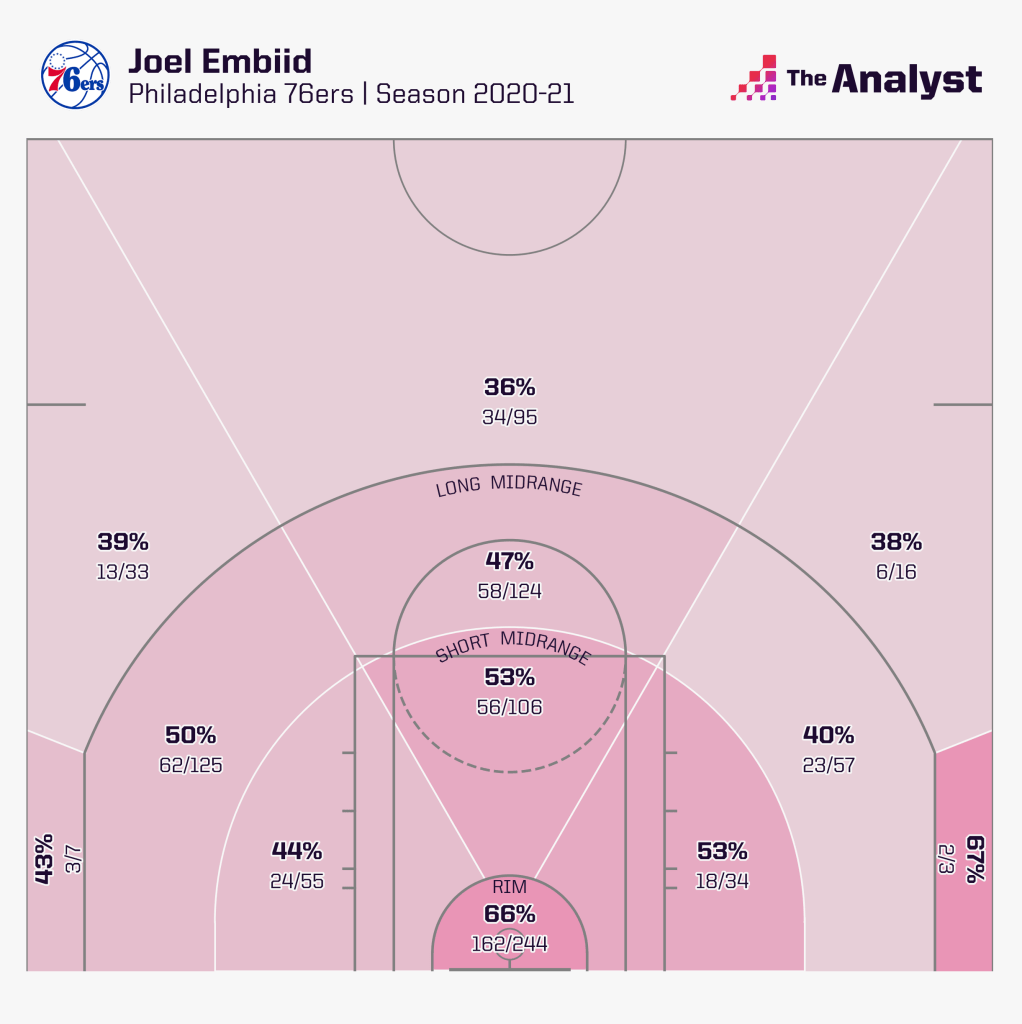
But there should be positive regression coming for Embiid once he shakes off the rust from his nine-game COVID absence. Last season, he shot 47.1% from between the paint and the 3-point line. This season, he’s at 36.8%.
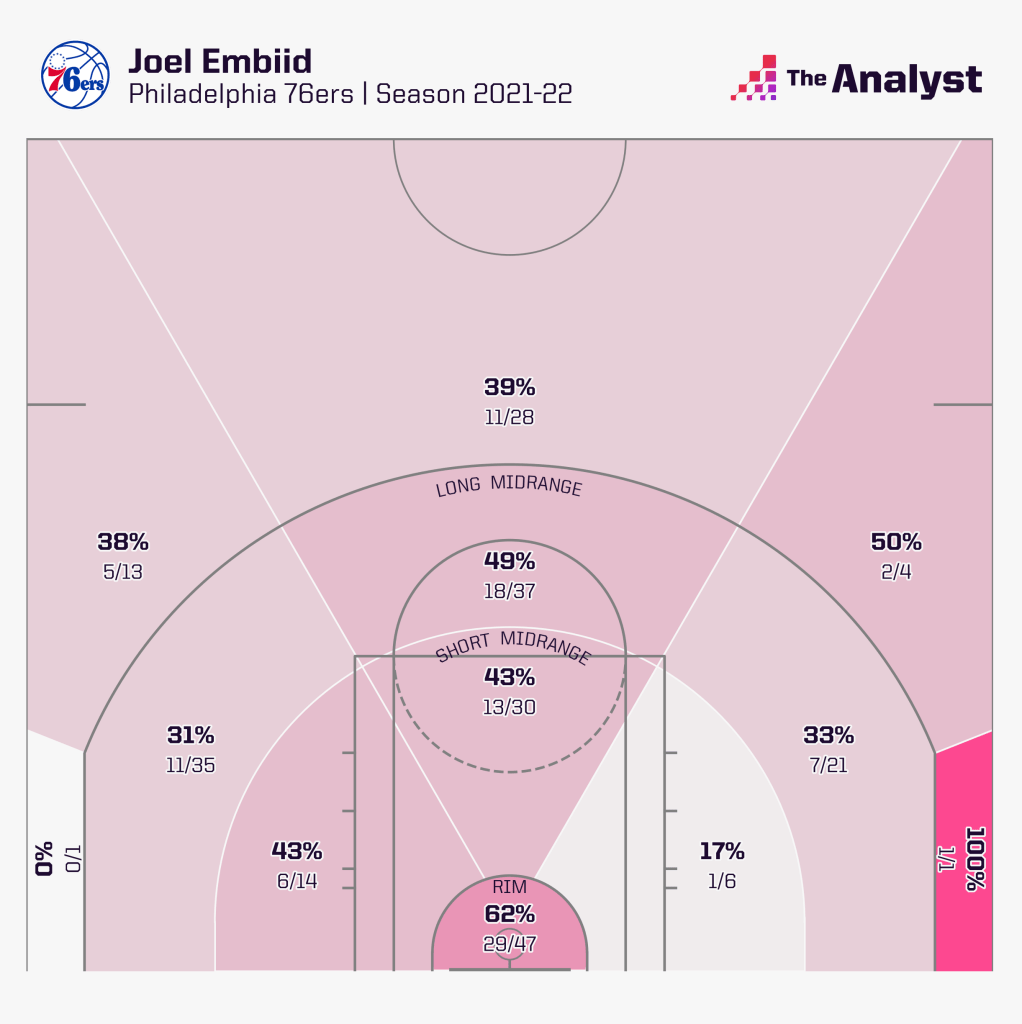
And yet … the Sixers are 10-4 with him in the lineup. They’re plus-7.5 points per 100 possessions when he’s on the floor. He’s fourth in our defensive D-DRIP and seventh overall, and his DELTA shows that he’s played slightly above expectations thus far despite his early struggles. Embiid is an All-Star even if he hasn’t been quite the SAME All-Star from years past.
Jarrett Allen, Cleveland Cavaliers
Allen is shooting 81.8% on more than seven attempts per game in the restricted area, which sounds like something Shaquille O’Neal would do in his Lakers days (he never exceeded 77.8% in purple and gold. Please don’t hold this random information against me, Your Shaqness.). The Cavs snuck into the Harden-to-Brooklyn deal last season and got him for a protected first-round pick, then some questioned why they’d give him five years and $100 million just to take up space next to star rookie Evan Mobley. The two have fit together quite nicely in Cleveland’s frontcourt, as they’re largely responsible for the Cavs having the league’s fourth-ranked defense (104.9 points per 100 possessions) despite playing the NBA’s toughest schedule. He’s perhaps the biggest reason Cavs opponents are shooting 57.5% in the restricted area this season, 11th lowest in the NBA. He’s in the top 10 in VORP, the top 20 in PER, and along with Mobley and Darius Garland – both of whom could be fixtures in this game in the future – is part of the first non-LeBron signs of life this franchise has seen since the days of Mark Price.
John Collins, Atlanta Hawks
The Hawks have been a bit of a disappointment after their run to the East finals, but it’s not for lack of effort from Collins. Collins is shooting nearly 75% in the restricted area and 50.9% elsewhere in the paint, and although his midrange game has faltered a bit, he’s hitting 41.3% of his 3s. He’s become a better passer this season and leads the league in points per possession (1.56) as the roll man in pick-and-roll (minimum 1.5 rolls per game). Atlanta is scoring 123.1 points per 100 possessions when he’s on the floor, which is the fifth-best individual offensive rating in the East. Collins brings it at both ends, and after showing the world his springy athleticism in the playoffs, he’s gotten even better in his fifth season.
Wild Cards
The last two spots in each conference go to two wild cards from any position, and it’s tough as usual – but maybe not in the way you’d think. Guys you’d expect to be here (James Harden, Bradley Beal, Jayson Tatum) have all struggled relative to their normal standards. Jaylen Brown’s inconsistency combined with his lack of availability hurts. You could make a case for Garland, who has been spectacular since Collin Sexton went out and is the offensive force behind what’s turning into an amazing foundation along with Allen and Mobley. Tyler Herro has seen his shooting volume increase significantly, but he’s helped carry Miami offensively for long stretches. Fred VanVleet has kept Toronto competitive, bouncing back from a rough shooting season while serving as the glue for a roster full of these guys. Malcolm Brogdon has done his best to keep Indiana afloat on a team that’s still struggling with the awkward fit of Domantas Sabonis and Myles Turner.
It’s hard to get there with Beal, Tatum or Brown. Perhaps they’ll be there in Cleveland, but they’re not deserving based on their resumes so far. Mobley has been amazing, but he still isn’t at an All-Star level offensively. Harden makes the cut here despite his poor shooting. He’s been much better after a rough first few weeks and has the Nets playing like a top-five offense over the past month. His free-throw attempts are up as he’s adjusted to the new way the whistle is being blown. Harden is at 110.1 points per 100 possessions this season, which is in the 59th percentile. Last season he had an offensive rating of 121.5, which was in the 85th percentile.
For the second spot, we’ll go with Sabonis. He’s still the Pacers’ best player even if Rick Carlisle hasn’t quite figured that out. Sabonis has received fewer elbow and post touches this season than last, when he often facilitated Indiana’s offense and dished out 6.7 assists per game. That’s down to 4.1 this season and he’s regressed as a 3-point shooter while taking fewer shots per game overall. But why? Sabonis is automatic in the paint, shooting 75.1% in the restricted area. His 64.0 true shooting percentage is a career high and ranks among the top 10 of players to take at least two 3s per game. He’s in the top 15 in VORP, 11th in the East in DRIP and has a plus-0.7 DELTA that is as good or better than any of the guys above him. The Pacers are 4-3 when he takes at least 15 shots and 6-13 otherwise. Get him more looks, Rick.
Maybe whoever coaches Team LeBron or Team Durant will.
Research support provided by Chase Weight. Data modeling by Matt Scott. Data visualizations by Peter McKeever and graphic design by Briggs Clinard.
